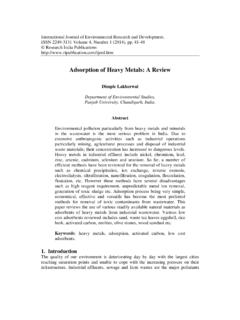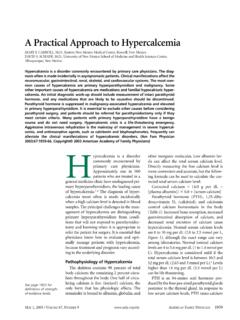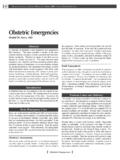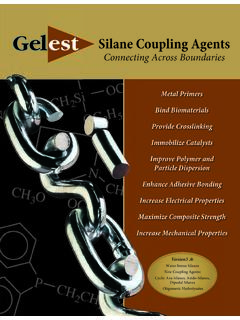Transcription of MULTI-EFFECT DISTILLATION (MED) - EOLSS
1 UNESCO EOLSSSAMPLE CHAPTERSWATER AND WASTE WATER treatment TECHNOLOGIES MULTI-EFFECT DISTILLATION (MED) Raphael Semiat Encyclopedia of Life Support Systems ( EOLSS ) MULTI-EFFECT DISTILLATION (MED) Raphael Semiat Rabin Desalination Laboratory, Grand Water Research Institute, Wolfson Faculty of Chemical Engineering Technion Israel Institute of Technology Technion City, Haifa 32000, Israel Keywords: concentrate, desalination, DISTILLATION , energy, environmental issues, heat transfer, mechanical, MED, MULTI-EFFECT evaporator, multi -stage, post- treatment , pre- treatment , scaling, thermal, vapor-compression. Contents 1. Introduction 2. Desalination Techniques membrane processes Evaporative techniques 3. MED Design Issues Heat transfer in MED Orientation and scaling 4. Design Equations Single-stage evaporator multi -stage evaporator Energy needs for vapor compression 5.
2 Operational Issues Pre- treatment Product quality Product post- treatment Corrosion protection Scale prevention Non-condensable gases 6. Environmental, Energy Issues and Future Trends Environmental aspects Energy consumption Product cost 7. Future Trends 8. Conclusions Glossary Bibliography Summary The development of desalination plants in recent years and the estimation of increased trends in desalination directions are increasing the interest in understanding desalination plants currently in use. The cost of desalinated water is still high for many people, so there is a need to learn how to reduce costs as well as understand how the techniques work before trying to develop new technologies. UNESCO EOLSSSAMPLE CHAPTERSWATER AND WASTE WATER treatment TECHNOLOGIES MULTI-EFFECT DISTILLATION (MED) Raphael Semiat Encyclopedia of Life Support Systems ( EOLSS ) This chapter describes the subject of MULTI-EFFECT DISTILLATION (MED).
3 The technology, which belongs to the field of evaporation techniques, is explained in detail and different designs are included. Design equations are also given based on heat balance, flow configuration and heat transfer mechanisms in the system . Related subjects such as energy needed, the energy source, environmental issues, operational technologies and most common problems are also explained. A comparison with other techniques and recommendations for future improvements are given. 1. Introduction The demand for fresh water has increased significantly since 1990 for many reasons, including, on the one hand, the increase in world population accompanied by the increase in standards of living, and, on the other hand, global warming followed by climate changes and desertification.
4 Governments and water industries are seeking different solutions for better utilization of available water, thereby increasing the efficiency of growth crops, solutions for better wastewater treatment , and the development of new water sources and improved desalination techniques. Many desalination techniques were considered over the years. Some survived the economic battle and are currently in use in different places around the globe. Others did not make it, yet are being reviewed from time to time in order to seek possible better techniques. Two main directions are used for industrial water production: thermal techniques and membrane -based techniques. Thermal techniques include the freezing technique that was abandoned and current techniques that are still responsible for more than 50% of the world desalination consumption: multi -Stage Flash (MSF) evaporation, which is still the most commonly used desalination technique, and MULTI-EFFECT DISTILLATION (MED), with a variation as vapor, thermal or mechanical compression, where the differences are in energy source and recovery (Awerbuch, 1997).
5 The MED technique is the most sophisticated evaporation desalination technique (Ophir & Weinberg, 1997). It is based on know-how in fluid mechanics of falling films, as well as on the understanding of heat transfer mechanisms and the phenomena of a double film of condensing vapor on one side of the heat transfer surface and the evaporation of falling film without boiling on the other side. This chapter aims at describing the technology related to the MED process. 2. Desalination Techniques Many desalination processes were proposed over the years; only a few survived the crucial road to produce the cheapest, yet most valuable, product on earth water. The most successful techniques are summarized briefly below (Porteous, 1975; Buros et al., 1981; Semiat, 2000; El-Dessouky & Etouney, 2002).
6 membrane Processes membrane techniques for water desalination are based on different types of molecular level filters membranes. The most common technique that aims at taking over the entire market of desalination processes is reverse osmosis. UNESCO EOLSSSAMPLE CHAPTERSWATER AND WASTE WATER treatment TECHNOLOGIES MULTI-EFFECT DISTILLATION (MED) Raphael Semiat Encyclopedia of Life Support Systems ( EOLSS ) Reverse Osmosis (RO) Desalination with reverse osmosis membranes is a process whereby saline water under pressure is transferred along a membrane . The pressure applied is high enough to overcome the osmotic pressure of the dissolved salt in feed solution. The osmotic pressure of a solution is proportional to the concentration of the dissolved matter, salts in water, starch or sugar, etc.
7 (Faller, 1999). Salts rejected by the membrane are removed from the membrane with the flow of concentrated solution while fresh salt solution is fed to the membrane . The permeate the fresh water product exits the lower pressure side of the membrane . Nano-Filtration Nano-Filtration is based on a loose membrane that allows partial passage of monovalent ions (mainly Na+ and Cl-) while partially rejecting the bivalent ions. It is used mainly in the desalination of brackish water of low salt concentration. Currently, the cost of these membranes is similar to the cost of RO membranes, so there is not much incentive to prefer these membranes over RO membranes. Ultra-Filtration and Micro-Filtration Ultra-Filtration and Micro-Filtration membranes contain large pores that allow the passage of free salts while preventing the passage of different sized suspended matter, down to nano-sized particles and colloids passing through the membranes, depending on pore size.
8 These membranes are used mainly for wastewater treatment and have started to take their place in the pre- treatment of water along with other desalination techniques. Electro-dialysis Electro-dialysis is based on the application of an electrical field across a pair of ion-selective membranes, causing the different ion salts to move through the membranes into a concentrated solution, leaving behind a diluting solution. Here, unlike other desalination technologies, the salts are removed from the feed water. The feed water should be free of suspended solids, organic matter and non-ionic contaminants that accumulate in the product (Thampy et al., 1999). While reverse osmosis may be used for all types of salt water, the nano-filtration and electro-dialysis techniques are more suitable for brackish water.
9 Evaporative Techniques Traditionally, evaporation techniques, especially MSF, have controlled the market of desalination techniques. Since 2004,, this trend has changed since reverse osmosis has proven to work properly and consume less energy. The question is still the final cost of the product, while preserving the environment. Evaporation techniques not only stand alone, but are now being considered as membrane evaporation techniques on the one hand and possibly a second stage for increasing recovery following RO desalination, UNESCO EOLSSSAMPLE CHAPTERSWATER AND WASTE WATER treatment TECHNOLOGIES MULTI-EFFECT DISTILLATION (MED) Raphael Semiat Encyclopedia of Life Support Systems ( EOLSS ) approaching zero discharge. These trends still have long way to go before implementation.
10 multi -Stage Flash multi -Stage Flash (MSF) DISTILLATION is based on condensing low-pressure steam as a heat source for the evaporation of seawater. It is still considered the simplest and most common technique in use. It has been in operation commercially for more than 60 years (Awerbuch, 1997). The technique is based on passing seawater through long, closed pipes passing through a series of flash chambers where hot seawater allows flashing along the bottom of the chambers. Vapor from the flash chambers heat the feed water flowing in the pipes. More heat is added in order to increase the temperature of the feed water to the initial high temperature, around 110oC. This is done with the use of low-pressure steam, usually taken from a back-pressure turbine in a power station.













